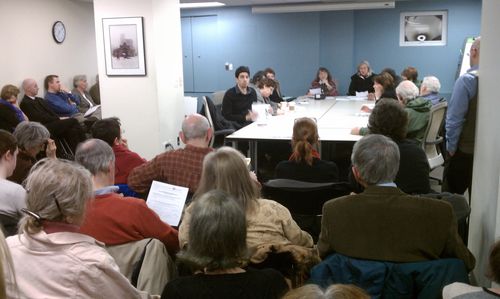Another day, another resolution from Community Board 7. This volunteer board of neighborhood residents, hand picked by Councilwoman Gale Brewer and Borough President Scott Stringer, voted unanimously last night to oppose the conversion of the Alexander Hotel into a mens shelter, a story I first broke here.
The resolution, though noble, left some questions unanswered:
- What good is a non-binding resolution from CB7 when the Department of Homeless Services runs scared from its constituents?
- Why was a strongly worded amendment to that resolution narrowly voted down?
- Where was the resolution condemning DHS's bad behavior last week?
- What effect will Brewer's opposition have when she in fact advocated for the bad legislation that created this problem in the first place?
As one neighborhood resident put it in his comments to the board (video above): "Tomorrow is Groundhog Day, and I feel like we're reliving what happened previously on 94th Street and even the last couple of meetings. ... the people in this community care about what is happening to our property values and what is happening to our neighborhood."
The Columbia Spectator has published its own account of the evening:
Residents took another step Tuesday night in what has been a long—and loud—fight to keep another homeless shelter from coming to the Upper West Side.
At its full board meeting, Community Board 7 unanimously passed a resolution strongly opposing a transitional shelter at the Hotel Alexander on 94th Street...
“The community board is doing their part of the game,” 94th Street resident Itzhak Epstein said.
Epstein said he’s glad the resolution passed, including the call for a “fair share” analysis to examine the concentration of homeless shelters on the Upper West Side, but he’s not convinced it will carry much weight since community board resolutions are non-binding.
“I’m in favor, but as I said, ‘strongly oppose’ means the community board can’t do anything,” he said. “What will the mayor’s office do? Nothing. It’s a done deal, the government will go on and do as it wishes.”
Will this government, in fact, go on and do as it wishes? Is our local representation more intractable than foreign dictatorships?
If the recent community pushback is any indication, the mood of this neighborhood has changed. Its residents are starting to question their leadership, especially those that hide behind a rhetoric of benevolence while creating legislation that is good for no one. This was the message that came out from the community group Neighborhood in the Nineties when it recently indicated how concerned residents can continue to express their opposition to the shelter and the legislation that opens the way for more:
What Should WE do? 1. Get on the phone.
START with City Council Member Gale Brewer.
SWAMP HER OFFICE WITH CALLS: 212.788.6975
Gale founded the Task Force that took on the hotels in the name of affordable housing (a worthy, but unattainable goal). Although the bill was passed in Albany, it is her responsibility as our representative to take steps to stop the flooding of this district with more special needs populations.
Ask Gale Brewer to use all her resources, do all that is in her power N O W !!!:
· Issue a City Council Resolution, hold Hearings, have a News Conference demanding an end to No-Bid Contracts that waste our taxpayer dollars while doing nothing to provide real housing for the homeless
· Issue a City Council Resolution and hold Hearings on the issuance of no-bid contracts by the Mayor’s Office and City Agencies. There should be a Moratorium on rich contracts to buildings owners for housing special needs/homeless populations immediately. The City needs a long-term plan to house the homeless in appropriate facilities throughout the City NOW!!
· Request that she show up at the Community Board meeting Tuesday. [ED NOTE--she did not show up to last night's meeting, and instead Brewer was shouted down at a protest in Brooklyn concerning her opposition to a new neighborhood charter school]
Below is a post-mortem report on the CB meeting from Aaron Biller, president of Neighborhood in the Nineties--











